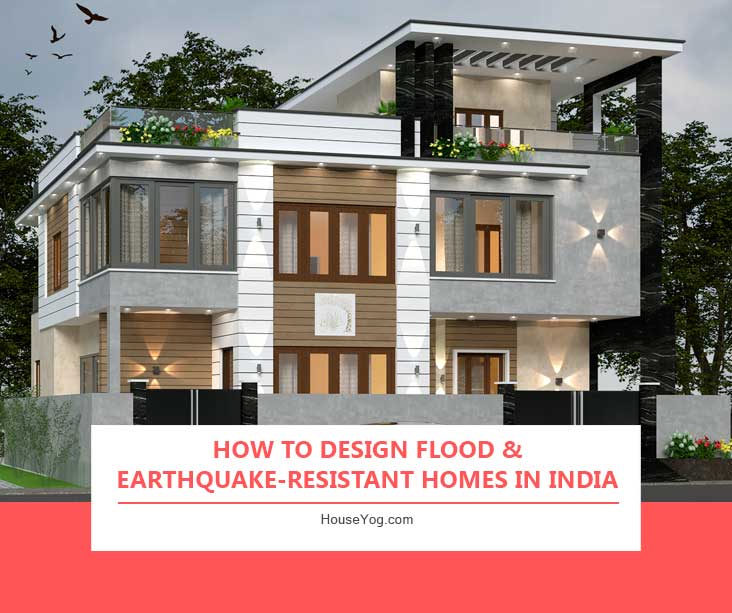Smart Architecture for Safer Living in Bihar, Jharkhand & Beyond
Every year, thousands of homes in India suffer structural damage due to floods or earthquakes, particularly in vulnerable regions such as Bihar, Assam, Uttarakhand, and parts of the Northeast. Sadly, most of this damage can be avoided with thoughtful architectural design and planning.
Whether you’re planning a new home in a flood-prone area like Madhubani & Darbhanga or an earthquake-sensitive region near Ranchi or Guwahati, building a disaster-resistant home is not a luxury, but it’s a necessity.
In this guide, we’ll walk you through the architectural strategies, structural planning, and smart materials that can help you build a safe and long-lasting home without breaking the bank.
1. Flood-Prone Areas: The Hidden Risks of Poor Planning
Floods don’t just disrupt, they damage and destroy. In low-lying and poorly planned areas of Bihar and West Bengal, houses without elevated plinths or proper drainage often suffer foundation damage, dampness, and mould infestation within months of construction.
If you’re planning a home in flood-prone zones like Darbhanga, Samastipur, or North Bengal, here’s what you need to get right from day one:
- Always build your plinth at least 2–3 feet above road level (or above the last recorded flood level).
- Provide drainage slopes away from the building.
- Avoid low-lying plots unless proper land filling is done.
- Include a ventilated crawl space (plinth gap) if ground moisture is high.
In Bihar and Bengal, many flood-prone homes can reduce risk simply by raising the floor slab and optimising rainwater outlets correctly.
2. Features of a Flood-Resistant House
Beyond elevation, it’s the materials and techniques you choose that determine how your home weathers the flood. A flood-resistant house uses a combination of smart finishes, protective detailing, and material choices that reduce water absorption and damage.
Consider implementing the following design features:
- Brickwork up to 2 feet with waterproof plaster prevents water seepage.
- Use cement-based paint or exterior wall protection.
- Avoid wooden doors/windows at ground level.
- Install non-return valves in the drainage to prevent backflow.
3. Earthquake Zones in India: Know Where You Stand
Before designing for seismic resistance, it’s critical to understand your location’s seismic risk. India’s building code divides the country into Zones II to V, and your district determines the level of reinforcement your house needs.
If you’re in seismic zones like Patna, Ranchi, or Guwahati, you must build accordingly. Use this Seismic Zone Map of India to check your area.
4. RCC Design for Earthquake Resistance
It’s not enough to just “use RCC”, how you design and reinforce it can make all the difference during an earthquake.
Proper RCC detailing ensures that columns, beams, and joints behave like a unified frame, absorbing and distributing seismic energy effectively.
Here’s what good RCC design should include:
- Use closed stirrups for column reinforcement.
- Maintain proper lap length and anchoring.
- Ensure beam-column joints are ductile and confined.
- Avoid long unsupported walls.
Always follow IS 1893 and IS 456 codes for seismic design in India.
5. Column, Beam, and Foundation Tips
Your structural grid is the skeleton of your house. Poor column spacing or unsupported projections often cause structural failure during tremors.
Good architectural planning should ensure strength, stability, and continuity across all load-bearing elements.
Keep these foundation and framing tips in mind:
- Columns should be evenly spaced and avoid re-entrant corners (L- or T-shapes without reinforcement).
- Avoid cantilevered slabs or balconies without seismic detailing.
- Use a raft or isolated footing with tie beams in seismic areas.
6. Use Lightweight Roofing & Flexible Materials
Heavy roofs and brittle materials can turn deadly in seismic events. In regions like Northeast India or Uttarakhand, choosing lightweight and flexible components can significantly reduce risk.
Here’s what we recommend for safer roofing and interiors:
- Steel trusses with metal/tile roof sheets instead of concrete slabs
- Lightweight internal walls using hollow blocks or AAC blocks
- Flexible joint fillers to prevent cracking
7. Soil Testing & Drainage: A Must for Safe Design
One of the most overlooked aspects of flood and earthquake resistance is the ground itself. Without knowing the soil’s strength or moisture level, designing a safe foundation is like building on guesswork.
Soil testing is the process of analyzing a plot’s soil to determine its bearing capacity, moisture content, compaction, and the presence of salts, clay etc. It helps build the right structure for your building. Here’s why it is important and why it matters:
- Some soils swell (black cotton) or shrink, leading to foundation cracks.
- High water table areas (like flood zones in North Bihar) need under-reamed piles or raft foundations.
Our site planning service includes guidance for soil testing and foundation selection.
8. Common Myths vs Best Practices
Homeowners often rely on hearsay or partial knowledge when building in risky zones. But ignoring structural realities can cost you heavily.
Let’s bust some myths and show you the facts:
| Myth | Reality |
| RCC alone is enough for earthquake safety | Only if designed as per IS codes with proper detailing |
| Brick is better than concrete in flood zones | Wrong – bricks absorb water and need protection |
| All plots are safe to build | Soil & water logging conditions must be tested |
| Vastu is enough for home safety | Vastu adds value, but structural safety is non-negotiable |
9. How Houseyog Designs Safer Homes
At Houseyog, we don’t just draw plans — we engineer resilient homes for Indian conditions. Our design approach blends:
- Local site factors (soil, flood history, seismic zone)
- Smart architecture and Vastu where needed
- IS-compliant structural drawings
- Affordable to build and maintain
Whether it’s a 2BHK on a flood-prone plot or a multi-storey home in a seismic zone, we ensure safety without compromising your budget.
Call us at +91 75960 58808 for a free consultation today.
FAQ: Flood and Earthquake Resistant Homes in India
Yes. Soil testing helps determine load-bearing capacity, moisture retention, and water table level, all critical for designing the right foundation. In high-risk zones like Bihar, it’s a must.
A minimum of 2-3 feet above the road level is recommended, or above the highest historical flood level in your area. This prevents water ingress and moisture seepage.
The key IS codes include:
IS 1893 (Earthquake design)
IS 456 (RCC construction)
IS 4326 (Earthquake-resistant design and construction of buildings)
Yes. Steel trusses with sheet roofing are lighter, which reduces seismic loads and risk. Ideal for Northeast and Himalayan belt homes.
We provide custom house plans, IS-code compliant structural drawings, and expert site planning tailored for flood and seismic zones across Bihar, Jharkhand, and other cities. Call us at +91 75960 58808 or get started here.
Over to You: Build Safer, Smarter Homes with Houseyog
Floods and earthquakes may be natural, but the damage they cause often isn’t. With smart planning, the right materials, and professional support, your dream home can stand strong for generations.
Need help with planning or structural design? Contact Houseyog or call +91 75960 58808 to get started.






